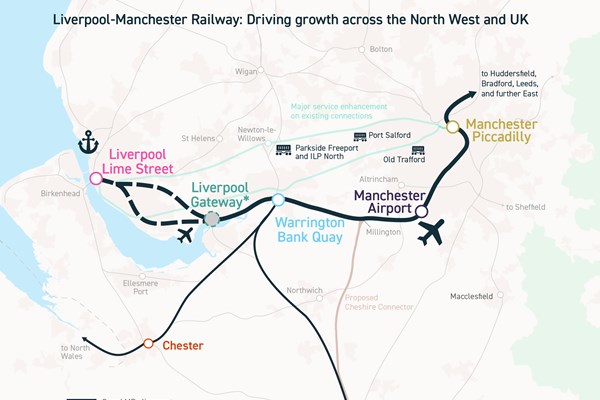A bold new railway line connecting Liverpool and Manchester has the potential to unleash a staggering £90 billion economic transformation across the North West and could provide a blueprint for how major infrastructure projects are delivered in the UK, regional leaders have announced.
Mayors Steve Rotheram and Andy Burnham, alongside former Rail Minister Huw Merriman and key civic and business figures from across the North West, are today outlining their proposals for a new Liverpool-Manchester Railway. They argue that the scheme would generate jobs, drive growth, and stimulate regeneration throughout the region, while also establishing a more effective model for building large-scale projects: led locally, delivered more swiftly, and designed with communities at its heart.
The leaders are urging the government to collaborate on the plans, asserting that a firm commitment now would pave the way for construction to begin in the early 2030s. This, they contend, would provide certainty for investors and help retain the skilled workforce built up during the delivery of HS2.
A report published today details the compelling case for the new line, which would run from Liverpool Lime Street to Manchester Piccadilly, with intermediate stops at a new Liverpool Gateway station, Warrington Bank Quay, and Manchester Airport. The report estimates that the construction phase alone could inject a £15 billion boost into the economy and create 22,000 jobs.
However, the impact is projected to extend far beyond the immediate route and construction benefits. The railway is envisioned as a crucial component of the Northern Arc – an emerging economic corridor stretching from Merseyside to the Pennines and beyond. Recent analysis by Metro Dynamics suggests that, as part of the Arc, securing the growth trajectory of Greater Manchester, Cheshire and Warrington, and the Liverpool City Region could add a cumulative £90 billion in Gross Value Added (GVA) to the UK economy by 2040 and effectively double the size of the region’s economy within the next three decades.
Despite being geographically shorter than both London’s Elizabeth Line and the proposed East West Rail link, the new line is predicted to have a significant impact. It would free up capacity on existing local rail lines, drastically reduce journey times, and bring over half a million additional people within a 30-minute commute of both Liverpool and Manchester city centres.
The report also champions a fresh approach to infrastructure delivery – one that is rooted in local knowledge, supported by private investment, and shaped by the latest technological advancements. Drawing lessons from past national schemes, the proposal advocates for a locally-led model designed to avoid delays and deliver better value for money.
Huw Merriman chairs the Liverpool-Manchester Railway Partnership Board, an expert panel advising on the optimal delivery of the project. The board is jointly calling for the line to be included in the government’s upcoming 10-Year Infrastructure Strategy and for ministers to endorse this new collaborative delivery model.
The ambitious plans also include the creation of five new ‘growth opportunity areas’ around each of the proposed stations – Liverpool Lime Street, Liverpool Gateway, Warrington Bank Quay, Manchester Airport, and Manchester Piccadilly. These zones are designed to support the development of new homes, jobs, and regeneration in anticipation of the railway’s arrival, potentially unlocking up to 500,000 homes and tens of thousands of jobs along the railway corridor.
Steve Rotheram, Mayor of the Liverpool City Region, said: “Two centuries ago, the Liverpool-Manchester Railway changed the world – kickstarting the railway age and powering a revolution in trade, travel and opportunity. Today, we have the chance to do it again. Our new line forms part of a wider vision to unlock £90bn of economic growth, and 500,000 new homes – the kind of transformation our region, and our country, desperately needs.
“There’s hardly a person in the North who hasn’t felt the frustration of slow, unreliable journeys or missed out on things because of creaking, outdated infrastructure. For them, this is far more than just building a new railway – it’s about opening the doors to opportunity. Connecting people to better jobs, unlocking new homes, and making it easier to enjoy everything our region has to offer – from concerts and football to family and friends.
“We’re putting forward a serious, deliverable plan that does things differently – developing plans at a regional level instead of a top-down approach. Not cap in hand, but shoulder to shoulder with government. We’re offering a new way of doing things: faster, fairer, and better value. With the right backing, we can get spades in the ground in the early 2030s and deliver the world-class railway we deserve.”
Andy Burnham, Mayor of Greater Manchester, said: “Just over 200 years ago, the world’s first passenger railway was built to connect Liverpool and Manchester, transforming the nation’s fortunes for centuries. But Victorian infrastructure is now acting as a brake on both on growth.
“A new Liverpool-Manchester Railway would be shorter than both London’s Elizabeth line and East West Rail connecting Oxford and Cambridge, but would punch well above its weight in both growing the UK’s economy and better connecting our high-growth sectors.
“For too long, such major infrastructure projects in the UK have been delivered in a top-down way. We want to work hand-in-hand with government to plan and deliver this railway from the ground up, enabling us to maintain our growth momentum for Greater Manchester. A new, locally-led delivery model will mean we can build our pipeline of regeneration, new homes, skilled jobs and green growth around the rail line with real certainty.”
Huw Merriman, Chair of the Liverpool-Manchester Railway Partnership Board, commented: “The government must invest in infrastructure to achieve its number one priority of growing the UK economy. With years of concentration in the south, there needs to be a fair balance of where that’s targeted and the time is ripe to rebalance the nation. The North West is growing and will grow faster with transport infrastructure connecting people to new homes, jobs and skills to equip them for life.
“The Liverpool-Manchester Railway is a credible and convincing project that will make the areas benefitting from the line and around the stations a highly-desirable place to live, invest and do business. Certainty on its delivery will be critical for both the North West’s and UK’s growth trajectory.
“Lessons must be learnt from past projects, including HS2, and a new locally-led model will be proof of devolution in action. The North West is unique in that we have mayors, civic and business leaders standing shoulder-to-shoulder ready to make this railway happen. Working together with government they can tackle the challenges that have come with such infrastructure delivery in the past.”
The previous government had committed £17 billion to the Liverpool-Manchester line following the cancellation of the northern leg of HS2. The project’s inclusion in the High Speed Rail Bill was subsequently confirmed in the 2024 King’s Speech.
Local leaders believe that by carefully sequencing the project, the railway could help retain the supply chains and specialist workforce already assembled for HS2, thereby avoiding the ‘boom and bust’ cycle that has hampered past infrastructure efforts.
From creating thousands of skilled jobs and reducing carbon emissions to unlocking significant investment and rebuilding local pride, the Liverpool-Manchester Railway is being presented as a central pillar of the country’s long-term plan for growth.




